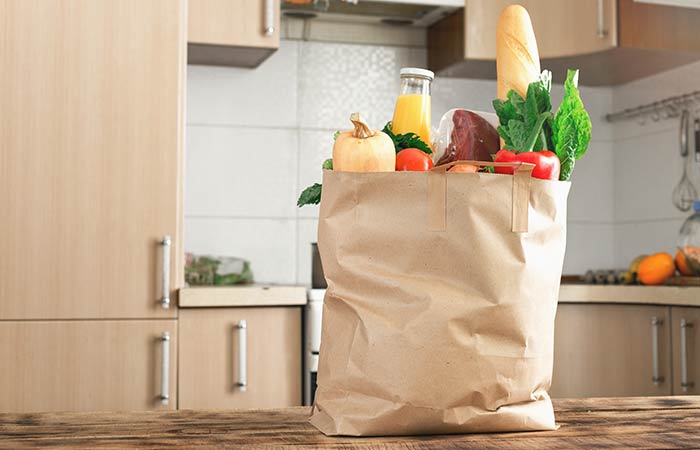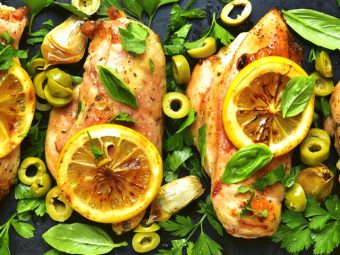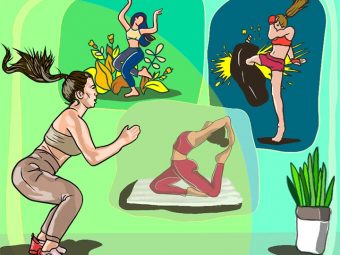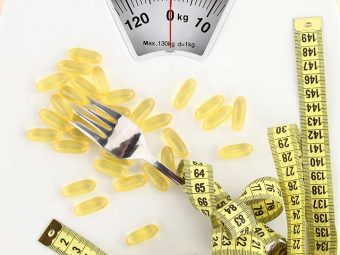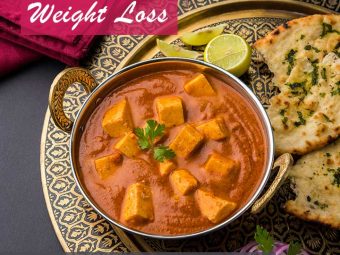How To Get Rid Of Upper Back Fat In 3 Weeks
Lose fat and build muscles in the right places to give you that sculpted look.

Upper back fat has a direct link to carb intolerance, insulin resistance, and high testosterone levels (1), (2). Lack of timely treatment may increase the risk of diabetes, PCOS, and infertility (3), (4), (5), (6). So, how to get rid of upper back fat?
Well, it is easier than you think. Do these 10 things listed in this post to shed upper back fat in 3 weeks. Get a toned and slimmer back. Continue reading.
In This Article
How To Lose Upper Back Fat
To lose upper back fat, you have to tweak your diet a little, follow an effective workout routine, and make a few changes to your lifestyle. Do these, and you will start noticing a difference in three weeks.
First, let’s see what kind of exercise you should focus on.
1. Upper Back Exercises
You need to target your upper back while exercising. Here’s a 10-minute, no equipment back exercise routine (timestamp below video).
- Windmill – 0:56
- Back Lift – 1:55
- Back Squeeze – 2:57
- Superman Fly – 3:56
- Wing Fly – 4:56
- Superman Hold – 5:57
- Arm + Leg Raise – 6:57
- Swimmers – 7:56
- Butterflies – 8:57
- Towel Face Pull – 9:57
Mix your workout routine with these effective back exercises using dumbbells and barbells.
Make sure you warm up before doing these exercises. Maintain good posture, breathe in and out while doing the exercises, and take at least 15 seconds break between each exercise.
Note: If you have a lower back problem, avoid exercises like swimmers, butterflies, superman hold, wing fly, and back lift. Talk to a physical therapist to know the best exercises for you.
Apart from targeting your back, you must aim to lose overall weight. Here’s how to do it.
2. Cardio The Fat Out
To lose back fat, you must also lose overall weight. Cardio involves aerobic exercises that help mobilize fat, improve metabolism, and enhance mood.
Do cardio every alternate day (do strength training on the other days) for at least 45 minutes. You may also do HIIT exercises to burn fat more effectively in a shorter period. You will start to lose weight, be proactive throughout the day, and sleep better.
3. Cut Down Calories
Cutting back on calories will help you create a negative energy balance. This means that along with exercise, if you consume fewer calories, you will help your body burn the stored fat and also prevent it from accumulating more fat.
But you must be careful with the calorie count. Your calorie intake should go up if you are active. Also, the calorie count is not the only factor. You should be aware of what you consume.
4. Consume Good Calories
Good calories are calories you consume from foods like veggies, fruits, nuts, seeds, whole grains, and lean proteins.
Veggies and fruits are low in calories, but you should be careful about the glycemic index of these foods.
Include lean protein sources like fish, skinless chicken breast, mushrooms, tofu, and beans and lentils in every meal. Protein helps increase satiety and thermogenesis and improves muscle tone (7).
Consume whole grains like brown rice, red rice, black rice, sorghum, barley, etc. These are loaded with dietary fiber, vitamins, and minerals. Whole grains are low in calories and help fill you up quickly and keep your hunger pangs at bay (8), (9).
Healthy fats like olive oil, nuts, seeds, avocados, avocado oil, fish oil, and rice bran oil are rich in PUFAs (polyunsaturated fats). PUFAs helps lower inflammation in the body (10), (11). This, in turn, helps prevent inflammation-induced weight gain (12), (13).
5. Give Your Kitchen A Makeover
Kitchen makeover is an important step while trying to lose back fat. If you do not have junk food in your pantry, you are less likely to be tempted to eat it. Donate the foods that might cause you to gain weight. Refill the cabinets with healthy and low-calorie foods.
6. Check Your Hormone Levels
Hormones play an important role when it comes to body fat distribution. Insulin resistance is closely related to back fat and belly fat accumulation. Consult a licensed physician to know if your insulin levels are higher than normal, which might be the reason for excessive weight gain.
7. Don’t Consume Junk Food
Junk foods like fries, burgers, pizzas, processed food, canned, and packaged foods, packaged fruit and vegetable juices, and frozen foods contain additives, preservatives, hidden calories, and food colors that are harmful and fattening. Avoid consuming these at all costs.
Cook at home to make your meal wholesome. Here are a few delicious and healthy recipes.
8. Walk It Out
Stress is one of the common reasons for weight gain (14). Work, school, relationships, finances, and social media can cause stress build-up (15). This results in increased production of cortisol and inflammation. Cortisol may interfere with your appetite, making you feel hungry more often (stress eating) (16), (17). Inflammation also adds in by causing unexplained weight gain.
Go out for a walk. You will feel a lot better, think clearly, and be able to decide based on logic, not emotion.
9. Get Some Shut-eye
Sleep is the best medicine for an overworked brain. Sleep deprivation has been linked to weight gain. Less sleep increases cortisol (stress hormone) levels and hunger and decreases insulin sensitivity (18). You need at least 6-7 hours of sleep to feel fresh and take on the next day’s work head-on.
10. Wear The Right Attire
Last but not least – your attire or what you wear is also important. Here’s what you can do.
Wear the right bra. This prevents making the bra bulge too obvious and visible.
Shop for clothes that suit your upper body shape. If you want to take attention away from your back, wear tops and dresses that have V-necks and stitch lines that make your upper body look slimmer (a lot of sportswear brands do that).
You may also wear color-blocked dresses that make your lower body look proportionate to the upper body, cool jackets, and makeup and accessories that highlight your best features.
These are the 10 things you must do for three weeks to see a visible difference.
Upper back fat accumulation may hint at insulin resistance, carbs intolerance, and high testosterone levels. While it may look flabby and stubborn to get rid of, it may not be as difficult it seems to begin with. Upper body exercises, cardio, and proper sleep routine, can help you lose weight from your upper back faster. Making the required diet and lifestyle changes and staying active overall may help to see a visible difference sooner.
Frequently Asked Questions
Does walking reduce back fat?
Regular walking may not specifically target upper back fat but it may help you lose overall body fat.
Can back fat go away?
Yes, a combination of a healthy diet, good sleep, and regular physical exercise can help you lose fat all over your body gradually.
References
- “Fat on chest and upper back linked with increased risk of insulin resistance” University of California, San Francisco.
- “Testosterone and the metabolic syndrome” Therapeutic Advances in Endocrinology and Metabolism, US National Library of Medicine, National Institutes of Health.
- “Insulin Resistance and Polycystic Ovary Syndrome.” Current Pharmaceutical Design, US National Library of Medicine, National Institutes of Health.
- “Risk Factors Contributing to Type 2 Diabetes and Recent Advances in the Treatment and Prevention” International Journal of Medical Sciences, US National Library of Medicine, National Institutes of Health.
- “Impact of obesity on infertility in women” Journal of the Turkish German Gynecological Association, US National Library of Medicine, National Institutes of Health.
- “Insulin resistance and obesity among infertile women with different polycystic ovary syndrome phenotypes” Scientific Reports, US National Library of Medicine, National Institutes of Health.
- “Protein, weight management, and satiety.” The American Journal of Clinical Nutrition, US National Library of Medicine, National Institutes of Health.
- “The Role of Whole Grains in Body Weight Regulation” Advances in Nutrition, US National Library of Medicine, National Institutes of Health.
- “Effects on satiation, satiety and food intake of wholegrain and refined grain pasta.” Appetite, US National Library of Medicine, National Institutes of Health.
- “Polyunsaturated fatty acids and inflammation.” IUBMB life, US National Library of Medicine, National Institutes of Health.
- “Polyunsaturated fatty acids, inflammatory processes and inflammatory bowel diseases.” Molecular Nutrition & Food Research, US National Library of Medicine, National Institutes of Health.
- “Inflammatory potential of diet, weight gain, and incidence of overweight/obesity: The SUN cohort.” Obesity, US National Library of Medicine, National Institutes of Health.
- “The inflammation highway: metabolism accelerates inflammatory traffic in obesity” Immunological Reviews, US National Library of Medicine, National Institutes of Health.
- “Stress as a common risk factor for obesity and addiction” Biological Psychiatry, US National Library of Medicine, National Institutes of Health.
- “Psychosocial Stress and Change in Weight Among US Adults” American Journal of Epidemiology, US National Library of Medicine, National Institutes of Health.
- “Stress, cortisol, and other appetite-related hormones: Prospective prediction of 6-month changes in food cravings and weight” Obesity, US National Library of Medicine, National Institutes of Health.
- “Stress-associated eating leads to obesity” International Journal of Health Sciences, US National Library of Medicine, National Institutes of Health.
- “Sleep and obesity” Current Opinion in Clinical Nutrition and Metabolic Care, US National Library of Medicine, National Institutes of Health.



